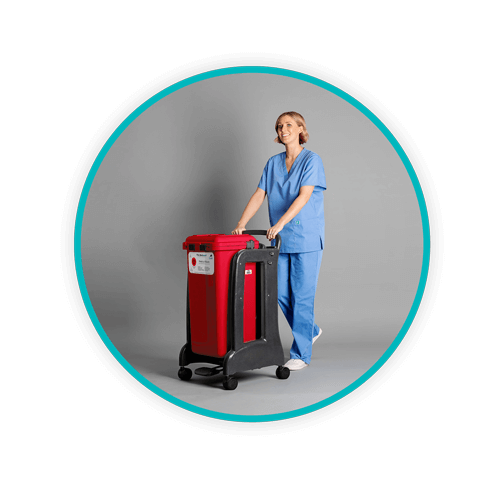What Are the Real Costs of Patient Interruptions?

A nurse can expect to be interrupted 12 times every hour. No one likes interruptions. For patients, this can be especially true. Whether it’s a private office setting, the ER, or in a hospital room, patient interruptions cause frustration for patients and staff. But unlike other instances when a fleeting interruption can get under our skin, patient interruptions can cause a ripple effect of negative consequences to occur. That’s why it’s essential to minimize interruptions wherever possible. Find out how interruptions can impact your organization and the steps you can take to proactively streamline workflows.
TOPICS WE WILL COVER:
1 / What are common causes of interruptions
2 / The risks of interruptions
3 / Patient interruptions impact HCAHPS Scores
4 / What is Waste Optimization and How Can it Minimize Patient Interruptions?
5 / Here to Help You Reduce Patient Interruptions
What are common causes of interruptions?
Patient interruptions are caused by a wide array of variables. You can probably think of at least a few reasons for them easily off the top of your head. They typically fall into one of three categories:
- People interruptions – colleagues, other patients, family
- Medical Device/Equipment interruptions – machine alerts, medical waste disposal, infusion pumps
- Electronic Device interruptions – EHRs, laptops, tablets and personal smartphones
Sometimes we’re not even the best judge of our own distractions and interruptions. Healthcare providers may list patients and phone calls as the top cause of interruptions, but one study found self-initiated conversations to be one of the leading causes of interruptions for staff. As new data reveals the extent to our dependence on our electronic devices, we may see a new wave of best practices and protocols to prevent adverse events from occurring because of device distraction.
The Risks of Interruptions
Interruptions aren’t just taxing on staff and patients, they can actually lead to adverse events, such as medication errors, one of the most common negative results of interruptions. Lack of concentration, the delaying of care and even worst case scenarios like wrong-site surgery are all tied to interruptions in the clinical setting. As this study notes, the human brain can only process information at a certain rate. When too many things happen at once, even the most seasoned RN can have trouble remembering everything that needs to be recalled.
Patient Interruptions Impact HCAHPS Scores
The Hospital Consumer Assessment of Healthcare Providers and Systems (HCAHPS) are where patients’ voices get heard. But unlike a Yelp or Google review, these scores directly impact reimbursement, which means those patient interruptions that seem like just a nuisance to the patient can add up to costing a healthcare organization dearly.
For the last decade, due to the Hospital Value-Based Purchasing Program, a hospital will be rewarded with Medicaid funding based on their positive HCAHPS scores. The less satisfied the patient, the lower the score; and the lower the score, the less funding a hospital can expect. In addition, HCAHPS scores are made public, and low scores can result in damage to the organization’s reputation, low consumer confidence, and a diminished ability to attract top talent.
What is Waste Optimization and How Can it Minimize Patient Interruptions?
Although it may be hard to stop patients from sending requests or alarms from sounding, there are some causes of interruptions that can be made more efficient. Waste disposal is one cause of patient interruptions that can be easily reviewed and new ways found to limit patient interruptions when it comes to the disposal of medical waste and sharps.
Daniels US has created an effective point of generation segregation system that streamlines the process so it is efficient and patient-centric. We call it waste optimization and it’s a series of steps we’re happy to walk you through to assess and respond to gaps in medical waste that can be the cause of patient interruptions. It begins with pharmaceutical and medical waste audits to assess the current state of your systems.
Here we use intelligent tracking technology to identify areas of incorrect segregation along with identifying the most appropriate containers for your needs and providing mounting and movement solutions. For instance, our mobilized medical waste containers can help to minimize patient interruptions by allowing the container to be easily moved as needed and removed from the patient environment.
Additionally, our experts can identify instances where universal waste is incorrectly disposed as medical waste, needlessly filling containers and thus increasing the number of patient interruptions (and adding disposal costs). By using intuitive user-friendly solutions, such as color-differentiated systems we can improve efficiencies in all of your healthcare waste streams, while minimizing volumes and encouraging cost savings.
The Daniels Waste Optimization system includes solutions for a variety of waste streams, such as:
- Sharps Disposal: Not only do our Sharpsmart collectors reduce the risk of injury, but they also efficiently hold more sharps, using a unique stacking disposal design, which maximizes the space inside the container, reducing overfill and the time spent swapping out containers.
- Medical Waste Disposal: Regulated medical waste can be more efficient with the Medismart, a bagless, foot-pedal operated system that allows for easier segregation.
- Chemotherapy Disposal: Oncology units can easily dispose of chemotherapy waste with the Chemosmart, which minimizes the touches that need to be involved in the process.
- Pharmaceutical Disposal: Our Pharmasmart collectors are designed to be tamper-proof and lockable, allowing for greater peace of mind and efficiency.

Here to Help You Reduce Patient Interruptions
At Daniels US, we don’t just supply the containers and the transportation for medical waste. We’re focused on providing innovative solutions to today’s most pressing medical waste challenges. Through extensive investigation and research, we’re able to offer insight and innovation into these challenges. And we’re happy to share our findings. When you work with Daniels Health, you have a partner who is committed to your organization’s safety, efficiency and care quality. Reach out to discuss your needs and see how Daniels can customize a solution that’s the right fit for your organization.
Let's Talk!
Your time is valuable, and we don’t want to play hard to get. You can either phone us directly on the details listed on our contact page, or feel free to fill out this short form and one of our team members will get back to you as quickly as possible.
